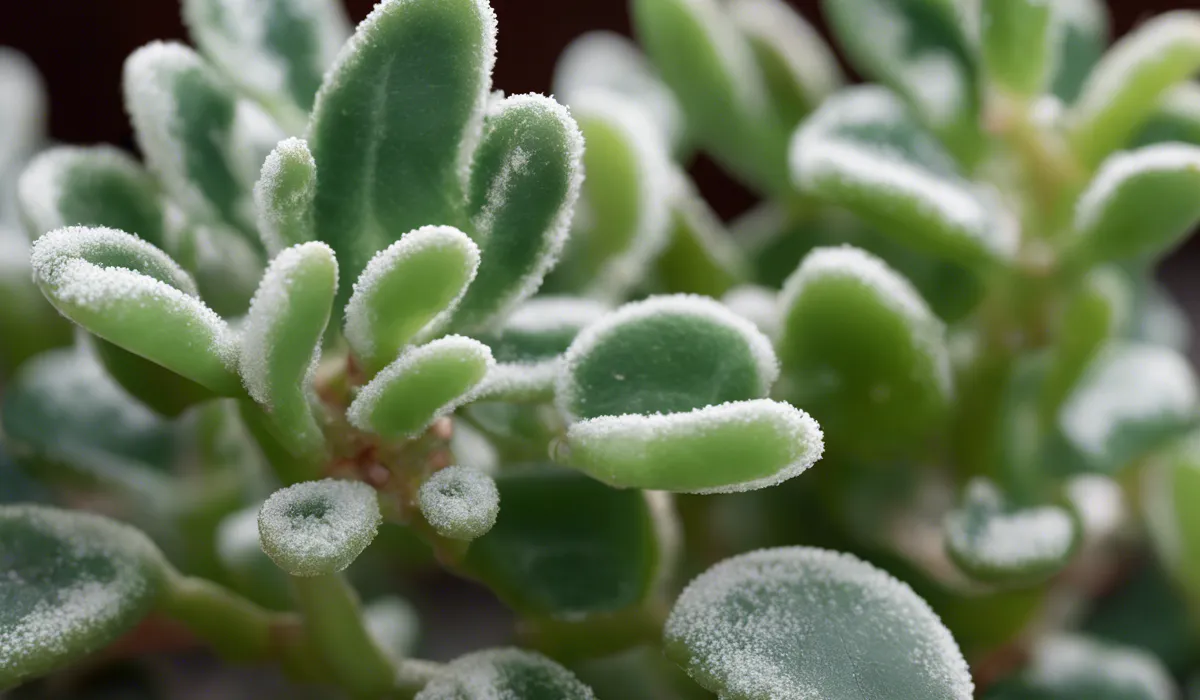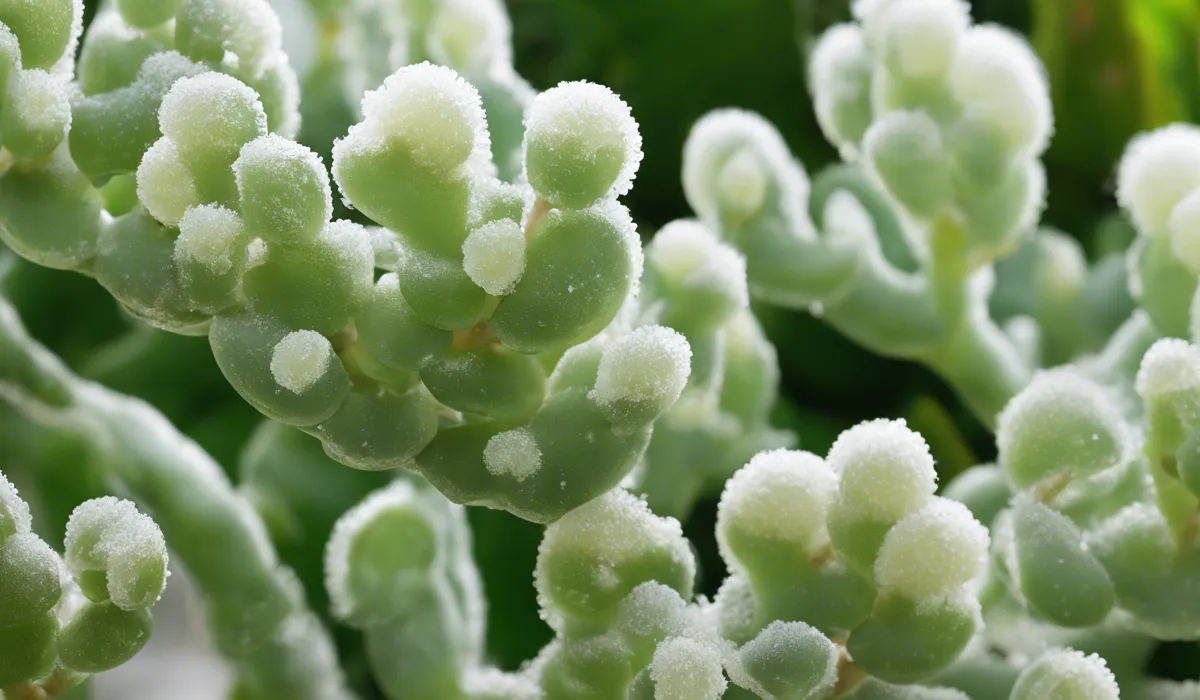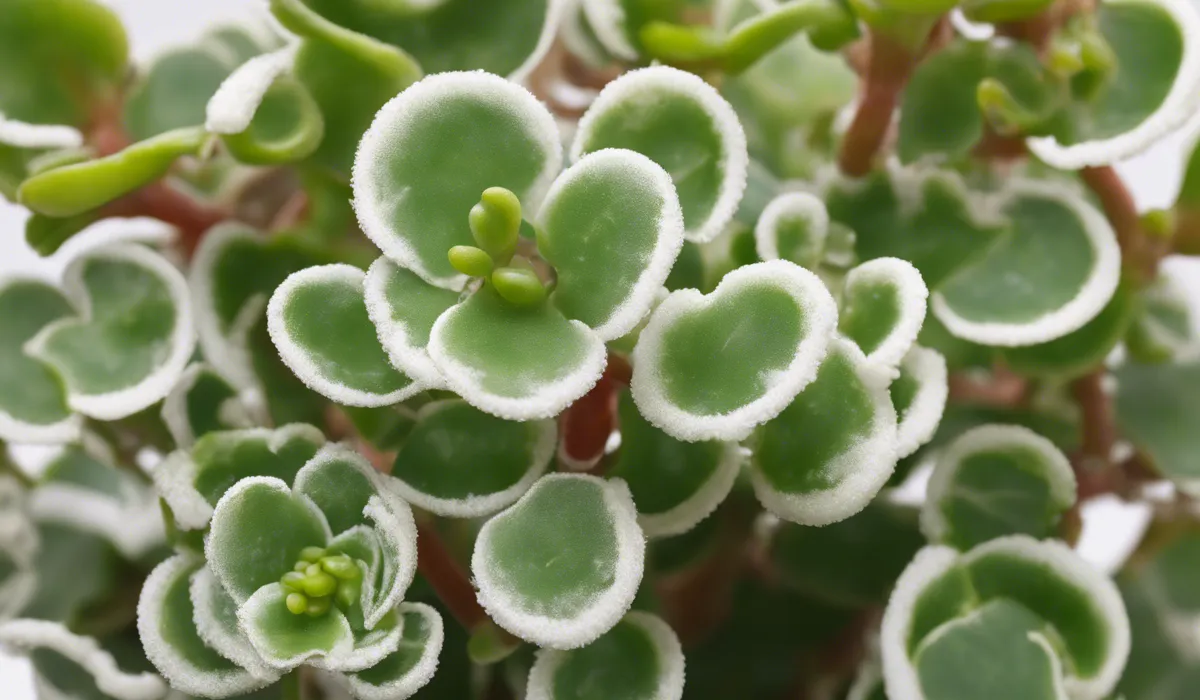To treat powdery mildew on a jade plant, gently wipe off the white residue with a damp cloth. Increase air circulation around the plant and reduce humidity. If necessary, apply a fungicide formulated for succulents, following label instructions. Avoid overwatering to prevent recurrence.
Identifying Powdery Mildew on Jade Plants

Description of Powdery Mildew
Powdery mildew presents itself as a white or gray powdery substance on the leaves and stems of jade plants.
It may first appear as small, white spots that gradually form a coating over the leaf surface. Infected leaves can become discolored, turning yellow or brown, and may eventually fall off.
It’s important to catch these signs early, as powdery mildew can spread quickly throughout the plant.
Common Conditions That Lead to Powdery Mildew Growth
Powdery mildew thrives in warm, dry environments with poor air circulation. Overcrowding of plants and excess moisture on leaves, often due to improper watering, can also contribute to its spread.
Ensuring your jade plant is in the right conditions can help prevent the development of mildew.
Effects of Powdery Mildew on the Health of Jade Plants
While powdery mildew may not kill a jade plant, it can weaken it by interfering with photosynthesis, the process by which plants make their food.
This can lead to stunted growth and reduced vigor. If left untreated, the plant may become more susceptible to other stresses and diseases.
Preventive Measures for Powdery Mildew

Proper Environmental Conditions to Prevent Mildew
Ideal Lighting
Jade plants require plenty of sunlight to thrive and avoid mildew. Place them in a location where they can get at least four hours of direct sunlight daily, preferably in the morning when the intensity is mild.
Optimal Watering Practices
Water jade plants sparingly, allowing the soil to dry out between waterings. When you do water, do it thoroughly so that excess water drains out—this will help keep humidity levels down.
Appropriate Air Circulation
Good air flow is essential for preventing powdery mildew. Ensure your jade plant isn’t crowded by other plants and that there’s plenty of space for air to circulate freely around it.
Sanitation and Cleanliness Around the Plant
Keep the area around your jade plant clean. Remove fallen leaves and debris that can harbor spores of powdery mildew or other pathogens. Disinfecting tools after use can also prevent the spread of disease.
Quarantine of New Plants Before Introduction
Before adding new plants to your collection, isolate them for a period to ensure they are not carrying powdery mildew or other diseases that could spread to your healthy plants.
Choosing Resistant Jade Plant Varieties
Selecting jade plant varieties that are resistant to powdery mildew is a proactive way to protect your garden. Research and ask local nurseries for recommendations on the best resistant varieties.
Treatment Options for Powdery Mildew Infestation

Natural Remedies and Homemade Solutions
Baking Soda Sprays
Baking soda is a common household item that can be used to create a fungicidal spray. Mix one teaspoon of baking soda with a quart of water and a few drops of liquid soap to help it adhere to the leaves.
Spray this solution on affected areas, being careful not to overdo it as it can cause damage if used excessively.
Milk Solution Treatments
Milk may help in bolstering plant immunity and suppressing powdery mildew. Dilute milk with water (40% milk to 60% water) and spray it onto the jade plant leaves.
The milk solution should be applied as a preventive measure and after signs of mildew appear.
Neem Oil Applications
Neem oil is a natural pesticide that can effectively treat powdery mildew. Apply a neem oil solution according to the product instructions, usually once a week until the mildew is under control.
Chemical Treatments
Suitable Fungicides for Jade Plants
There are fungicides specifically formulated for use on succulents and jade plants. Choose a product that is safe for your plant and environment, following the label’s instructions closely.
How to Safely Apply Chemical Treatments?
When applying chemical treatments, wear protective gear and avoid spraying on hot days or when the plant is under direct sunlight. Always test the product on a small area first to ensure it does not harm the plant.
Ongoing Care After Treatment
Monitoring Plant Recovery
After treating powdery mildew, watch your jade plant closely for signs of recovery or recurrence. New growth should be free of the powdery substance, and existing leaves should show improvement.
Adjusting Care Routine to Prevent Recurrence
To prevent powdery mildew from returning, adjust your jade plant’s care routine. This may include improving air circulation, adjusting watering habits, and ensuring the plant receives adequate light.
Incorporating these measures will help keep your jade plant healthy and free of powdery mildew.
Remember, if you’re looking for additional tips on plant care, exploring topics like the right size binoculars for an Alaska cruise can offer unexpected insights into the precision and care needed for various hobbies, including gardening.
Stay vigilant and proactive in your plant care practices to enjoy the beauty of thriving jade plants in your home or garden.
FAQs About Treating Powdery Mildew on Jade Plants
How can I remove powdery mildew from my jade plant?
To remove powdery mildew from a jade plant, gently wipe the white residue off the leaves with a damp cloth.
What can I do to prevent the spread of powdery mildew on my jade plant?
Increase air circulation around your jade plant and reduce the humidity in its environment to prevent the spread of powdery mildew.
Is it safe to use fungicide on a jade plant with powdery mildew?
Yes, it is safe to use a fungicide formulated for succulents on a jade plant with powdery mildew, but always follow the label instructions.
How does overwatering affect powdery mildew on jade plants?
Overwatering can create a humid environment that is conducive to the growth of powdery mildew, so it should be avoided to prevent recurrence.
Can improving air circulation help treat powdery mildew on a jade plant?
Yes, improving air circulation around the plant can help treat and prevent powdery mildew by reducing moisture and humidity.
Final Thoughts
To combat powdery mildew on jade plants, start by wiping the white residue with a moist cloth. Enhance the plant’s air flow and lower humidity levels.
Utilize succulent-specific fungicide as needed, adhering to the product’s directions. Prevent future outbreaks by ensuring the plant is not overwatered.
